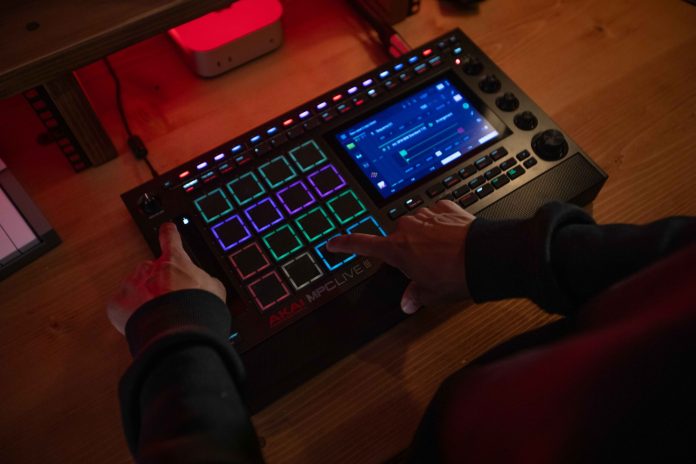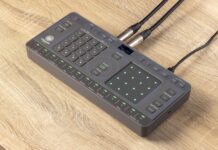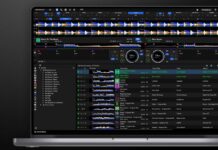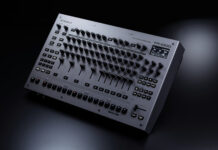Akai has officially unveiled the MPC Live III, the latest addition to its iconic line of standalone music production centers. Positioned as the most advanced MPC yet, the Live III brings an 8-core processor, 8GB of RAM, and a host of new tools designed for modern producers and performers. Among its standout features are MPCe 3D pads for expressive control, a dedicated 16-step sequencer, and a touchscreen Clip Matrix that enables real-time loop launching and arrangement without a laptop.
This release signals Akai’s push to make the MPC more than just a sampler or sketchpad. With built-in speakers, a condenser microphone, and a rechargeable battery, the MPC Live III is designed to be a truly portable all-in-one studio – a device equally at home in the studio, on stage, or on the road. For artists seeking laptop-level power in a standalone box, the MPC Live III aims to deliver a complete DAWless workflow from start to finish.
Key features
Let’s break down the major features that set the MPC Live III apart from its predecessors and competing grooveboxes:
- MPCe 3D Pads: Pressure, velocity, and X/Y movement for morphing samples and dynamic note shaping.
- Dedicated 16-Step Sequencer: Classic step programming grid for quick drum and pattern creation.
- Touchscreen Clip Matrix: Real-time audio and MIDI loop launching, Ableton-style, but fully standalone.
- Built-in Microphone + Speakers: Capture vocals, field recordings, or jam without extra gear.
- 8-Core CPU + 8GB RAM: Handles up to 32 plug-ins, 16 audio tracks, and stem separation with ease.
- MPC3 Pro Pack: Includes expanded effects, advanced clip tools, CV features, and Ableton Live import.
- Rechargeable Battery: Portable production anywhere – hotel rooms, park benches, or tour buses.
Tech specs
And while we’re here – a quick look at the spec sheet:
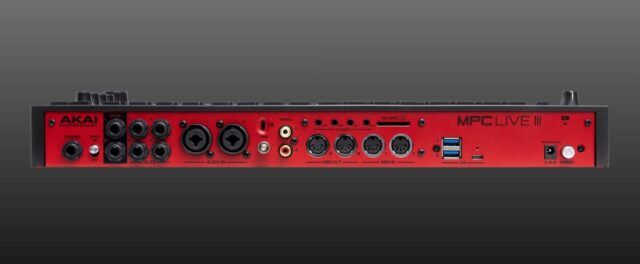
- Processor & Memory: 8-core CPU, 8GB RAM
- Pads: 16 MPCe pads with 3D X/Y control
- Sequencer: 16-step grid with performance strip
- Display: 7-inch multi-touch screen
- Audio: Built-in condenser mic, stereo speakers, 6 line outputs
- Tracks: Up to 32 plug-ins, 16 audio tracks
- Connectivity: XLR/TRS combo ins, USB-C audio/MIDI, CV/Gate, Wi-Fi + Bluetooth
- OS: MPC3 with Pro Pack (stems separation, effects, clip workflow)
- Power: Internal rechargeable battery
- Price: $1,699 USD / €1,649.99 / £1,399.99
MPCe 3D Pads: expressive control beyond velocity
A noteworthy innovation in the MPC Live III is its MPCe 3D pad system. While older drum pads gave you velocity and aftertouch, these pads sense X/Y movement for real-time sound shaping. You can bend pitch, morph between samples, or trigger nuanced note repeats directly from the pad surface. For finger drummers and live performers, the added expressiveness bridges the gap between hardware pads and more complex controllers.
16-Step Sequencer: classic programming in the MPC Live III
For the first time on an MPC, the Live III includes a dedicated 16-step sequencer panel. It’s a nod to the classic Roland x0x-style workflow and makes programming hats, kicks, and percussive runs faster than tapping pads.
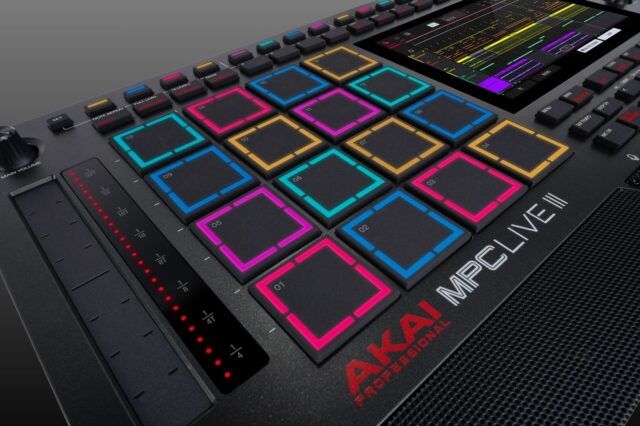
Live performers get the best of both worlds – pads for performance and a sequencer grid for structure – while Elektron or Korg users will feel more at home switching to the MPC environment.
Standalone loop launching with Clip Matrix
The addition of a Clip Matrix turns the MPC Live III into more than just a sampler. Similar to Ableton’s Session View, this feature lets you launch MIDI and audio loops in real time. DJs and producers can now improvise arrangements live, triggering stems or loops without a laptop. For hybrid sets, this means no CDJs, no Serato, and no DAW – just the MPC handling everything from loops to live improvisation.
Built-In speakers and microphone for portable production
The built-in condenser microphone and stereo speakers are not studio replacements, but they’re highly practical. Take a few potential scenarios as examples:
- A touring DJ can sketch edits in a hotel room.
- Field recordists can capture environmental samples directly.
- Vocalists can lay down scratch takes without an audio interface.
This makes the MPC Live III a fully self-contained idea machine – ideal for capturing inspiration anywhere.
8-Core Processor and 8GB RAM: real power under the hood
When it comes to addressing the build within this piece of gear, the 8-core processor and 8GB RAM are a major step forward. With these combined the Live III can now support up to 32 plug-in instances, 16 audio tracks, and stem separation at the same time. For producers, that means no more rationing effects or bouncing tracks early. The device finally has the muscle to handle complete productions – not just sketches – without crashing or freezing.
MPC3 Pro Pack: an expansion of tools to broaden your wheelhouse
The MPC Live III comes bundled with the MPC3 Pro Pack, which adds AIR effects, a new clip workflow, CV tools, Ableton Live import, and advanced timestretching. The pack is also available separately for other MPC3 OS devices.
For Live III buyers, it sweetens the deal, but it also hints at Akai’s growing ecosystem of paid add-ons. Whether this feels like expanded flexibility or an extra paywall will depend on your perspective.
Who it’s for – and whether it’s worth buying
The Akai MPC Live III is more than a minor upgrade. IIt’s Akai’s most serious attempt at a fully standalone music production center. With an 8-core processor, 8GB of RAM, and support for up to 32 plug-ins and 16 audio tracks, the Live III has the power to handle full track production. Add to that the new MPCe 3D pads with X/Y expressive control, the dedicated 16-step sequencer, and the Clip Matrix for real-time loop launching, and you get a box that pushes the MPC legacy firmly into the modern DAWless era.
At $1,699, however, this is not casual-purchase territory. For producers who own the MPC Live II and primarily use it as a sketchpad, the upgrade may not feel essential. The workflow improvements are significant, but they may not justify the price if your current MPC handles your needs. However, if you’re looking to finish full productions inside the box without bouncing to a computer, the MPC Live III finally offers the horsepower and workflow to make that realistic.
For touring producers and live performers, the MPC Live III could be a major upgrade. The combination of built-in microphone, stereo speakers, rechargeable battery, and performance-focused Clip Matrix means you can rehearse, sketch, and even perform without lugging extra gear or relying on a laptop. Hybrid DJ/producers may also find this box appealing – it opens the door to building sets around stems and loops triggered live, with expressive control through the 3D pads and performance strip.
If you prize standalone rigs, the MPC Live III is unique in its own right. Competitors like Elektron or Maschine offer excellent sequencing, but either lack true stem-handling or still depend on software integration. The Live III is a self-contained system that handles sequencing, sampling, stems, and performance effects with enough CPU power to keep up. If your goal is a truly DAWless setup, this is one of the most complete and powerful options currently available.
That said, for bedroom producers or casual creators, the investment may outweigh the benefits. If your workflow already revolves around a DAW and a MIDI controller, the MPC Live III could feel like expensive overlap. It shines brightest when used as the centerpiece of a setup, not as an accessory.
Final Word
In short, the Akai MPC Live III is the most advanced standalone MPC to date. If you’re ready to commit to making standalone hardware the core of your production and performance, it’s a purchase worth considering. For serious users, it could replace a laptop. For everyone else, it may be overkill. Either way, Akai has raised the bar in 2025 for what a portable music production center can be, and it ensures the MPC legacy continues to matter in the modern landscape.
The Akai MPC Live III is available now for $1,699 USD (€1,649.99 / £1,399.99). With its 8-core power, 3D pads, Clip Matrix, and portable all-in-one design, it’s built for producers who want a true standalone workflow – would you add it to your setup?

